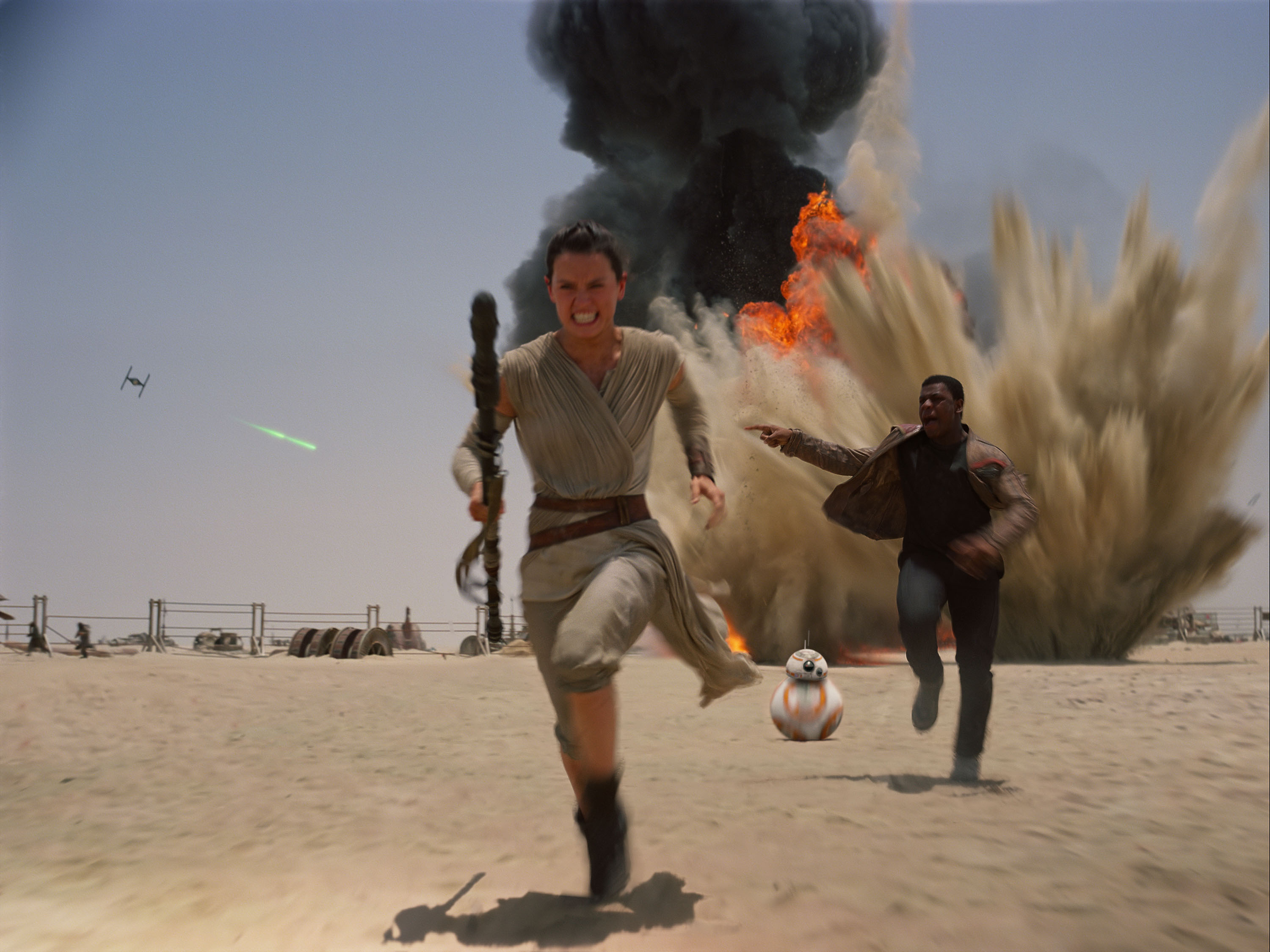WASHINGTON — After seven blockbuster episodes — eight if you count Mel Brooks’ hysterical Schwartz send-up — George Lucas’ “Star Wars” long ago transcended movies into the realm of ritualistic, even religious, phenomenon.
There is not a single franchise that has created more memorable characters, a roster of heroes and villains that are imitated by fans and instantly recognizable even to those who have never seen it.
Now, as we await “Star Wars: Episode VIII” next year, it’s time to leave the official Roman numeral episodes for the diverting one-off chapter “Rogue One: A Star Wars Story,” a unique film that leans less on Joseph Campbell mythology and more on the gritty combat sequences found in war flicks. Some folks will find this an iconoclastic attack on cherished franchise tradition. I won’t go that far.
If anything, “Rogue One” is a movie geared toward diehards rather than casual fans. That is to say, there is a certain down-in-the-weeds vibe to “Star Wars: Episode Three & Three-Quarters,” its stakes diluted by an air of inevitability as we know the outcome and miss the characters waiting off screen. And yet, somehow it manages to be pretty satisfying on its own terms. Enjoy it for what it is, you will.
Set between “Revenge of the Sith” and “A New Hope,” the premise is the stuff that fanboy dreams are made of. Recalling the “Clerks” cash-register debate over Death Star contractors, “Rogue One” opens with the Imperial Empire honing its planet-destroying weapon. Can the daughter of the Death Star designer steal the blueprints in time for the Rebel Alliance to mount a resistance? We all know the answer, as Luke Skywalker exploits this weapon’s flaw for a big bang at the end of “Star Wars” (1977).
Written by Chris Weitz (“About a Boy”) and Tony Gilroy (“The Bourne Trilogy”), it’s a lovely irony that this blueprint-stealing plot follows a much different blueprint, scrapping the opening text crawl, Jedis, lightsabers, even John Williams as composer. Sure, there are a few fun nods — including a killer Darth Vader cameo teased in the trailers — but this movie largely focuses on a new band of heroes.
Leading the way is Felicity Jones, whose Oscar nomination for “The Theory of Everything” (2014) catapulted her into blockbusters like Dan Brown’s “Inferno” (2016) and future award contenders like “A Monster Calls” (2016). In “Rogue One,” her Jyn Erso rivals Carrie Fisher’s Princess Leia and Daisy Ridley’s Rey as a butt-kicking heroine, only she’s asked to do it in a more morally ambiguous universe.
Like Luke Skywalker, she leads a rag-tag team of rebels: intelligence agent Cassian (Diego Luna, “Y Tu Mama Tambien”), defector pilot Bodhi (Riz Ahmed, “The Night Of”), droid K-2SO (Alan Tudyk, “I, Robot”), trigger-happy gunner Baze Malbus (Wen Jiang, “Let the Bullets Fly”) and blind spirit warrior Chirrut Îmwe (Donnie Yen, “Hero”), who repeats, “I am one with The Force, and The Force is with me.”
Along the way, we meet key figures from the Rebellion, including Forrest Whitaker as Saw Gerrera, the Onderon rebel leader who wheezes through a gas mask in his best Dennis Hopper “Blue Velvet” impression, and Genevieve O’Reilly as Mon Mothma, staunch political leader for the Rebel Alliance.
On the side of the Evil Empire, our primary villain is Orson Krennic (Ben Mendelsohn, “Black Sea”), director of advanced weapons research for the Imperial Military who’s now in charge of security on the Death Star. Thus, he reports to Death Star commander Grand Moff Tarkin, memorably played in 1977 by Peter Cushing, who actually died in 1994 but is gloriously resurrected with clever CGI here.
There are several of these digital tricks by director Gareth Edwards, who burst onto the scene with “Monsters” (2010) before remaking “Godzilla” (2014). But to his credit in “Rogue One,” he seems far less concerned with high-flying CGI battles than getting down in the trenches, relying less on fancy lightsabers and more on gritty laser shots at Stormtroopers and timed explosions of AT-AT walkers.
If you ever craved “Star Wars” meets “Saving Private Ryan,” this is your movie. You won’t see gory wounds — older kids will be fine — but there is a Normandy-style invasion. Call it “Saving Private Jyn.”
Ironically, the music composer of both those movies is nowhere to be found. This is the first of eight “Star Wars” scores not composed by John Williams, who will return for “Episode VIII” (2017) and “Episode IX” (2019). Instead, we get Oscar winner Michael Giacchino (“Up”), an accomplished composer in his own right who offers a rousing original score with some loving homages to Williams.
In many ways, the music is a microcosm of the film’s overall conundrum, boasting a number of unique strengths trapped in a “placeholder” structure where talented craftsmen do their best to enhance this tiny cog in a larger, more familiar wheel. When we see the ritual text at the outset — “A long time ago, in a galaxy far, far away” — we expect Williams’ blaring horns to explode on screen. Instead, we jump right into a space scene without the usual text crawl. It’s not a jarring flaw; just disappointing.
Part of the glory of “Episode VII: The Force Awakens” (2015) was that magical, goosebump-inducing ecstasy of re-entering our beloved fantasy world. J.J. Abrams found the perfect blend of weaving in nostalgic elements (“Chewie, we’re home”) while introducing fresh new characters (Gotta love that BB-8 droid). “Rogue One” isn’t as deft at balancing the two, creating a mini-disruption in The Force.
This might be refreshing if you want a different ride than the other “Star Wars” movies, but shouldn’t there be more crossover if “Rogue One” sits on the chronological doorstep of “A New Hope?” Orson Krennic is cool and all, but he’s no Darth Vader. Most prequels can’t use the same villain because the actor has aged, but Darth has a helmet! There’s no excuse to not make him the chief antagonist here.
So as much as we enjoy the finely-crafted action sequences, there’s a sinking feeling that the more-compelling characters are hiding off screen. Watching “Rogue One” with seldom-seen Vader is like an “Oz” prequel that shows only glimpses of the Wicked Witch and instead focuses on the nasty fella who designed her broomstick. For most of Act 2, you’ll wonder: “I wonder what Lord Vader is up to?”
Perhaps the writers wanted a fresh foil, but it seems like a missed opportunity. Agree to disagree.
The further we dive into the hyper-violent hyperspace of Act 2, old-school fans will begin to wonder where this darker, deadlier version of “Star Wars” is headed. At times, it feels like a different genre than the space westerns and Flash Gordon adventures we so closely associate with the series.
Thankfully, in its exceptional Act 3, “Rogue One” sticks the landing with one of the best finales in the entire series, sending fans out on a high note that will have some singing premature superlatives.
No, I’m not talking about the pre-credits surprise that links up nicely with “A New Hope.” There’s an even better image that comes a few scenes before that, as two pivotal characters stare off toward an ever-approaching horizon. This should have been the film’s final shot, underlining the key theme of sacrifice, but thou shalt not nitpick “Star Wars.” It’s an incredible shot that brought tears to my eyes.
Such a strong finish more than makes up for the other non-traditional elements, enough for us to deem the film a successful addition to the “Star Wars” canon. But while it’s a fun romp with a short-term payoff, the long-term health of the franchise would be better served if Disney/Lucasfilm waited more than a year between installments. Absence makes the heart — and The Force — grow fonder.
And so, decades from now, when “Star Wars: Episode XXL” hits the big screen, we’ll look back on the entire saga and say, “One of these films is not like the others.” The answer will be “Rogue One.”








